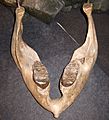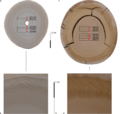Woolly mammoth facts for kids
The woolly mammoth (Mammuthus primigenius) was a giant, hairy elephant that lived during the Ice Age. We know about these amazing animals from their bones and even frozen bodies found in very cold places like northern North America and northern Eurasia. The best-preserved mammoths have been discovered in Siberia. Woolly mammoths are probably the most famous type of mammoth!
Quick facts for kids Woolly mammothsTemporal range: Pleistocene – Holocene
|
|
|---|---|
 |
|
| Woolly mammoth | |
| Scientific classification | |
| Kingdom: | |
| Class: | |
| Order: | |
| Family: | |
| Genus: | |
| Binomial name | |
| Mammuthus primigenius (Blumenbach, 1799)
|
|
These huge mammoths first appeared in Eurasia around 150,000 years ago. This was a time when large parts of the Earth were covered in ice.
Woolly mammoths lived at the same time as early humans. People hunted mammoths for food. They also used mammoth bones and tusks to make tools and even build shelters. Most woolly mammoths disappeared about 10,000 years ago, when the last Ice Age ended. However, a smaller group of them lived on Wrangel Island until about 1700 BC.
What Did Woolly Mammoths Look Like?
Woolly mammoths were very large elephants. They were covered in thick, shaggy hair to keep warm in the cold Ice Age climate. We know what they looked like from ancient Cave paintings found in caves in France and Spain. Woolly mammoths are closely related to today's Asian Elephants.
Images for kids
-
Copy of an interpretation of the "Adams mammoth" carcass from around 1800, with Johann Friedrich Blumenbach's handwriting
-
1930s illustration of the lectotype molars; the left one is now lost.
-
Georges Cuvier's 1796 comparison between the mandible of a woolly mammoth (bottom left and top right) and an Indian elephant (top left and bottom right)
-
Model at the Royal BC Museum
-
Cross sections of African elephant and woolly mammoth tusks; growth rings can be used to determine age
-
Mural depicting a herd walking near the Somme River in France, by Charles R. Knight, 1916
-
Woolly mammoth engraved on ivory, discovered by Édouard Lartet in 1864
-
Palaeolithic projectile points made from mammoth ivory, Pekárna cave
-
Mounted "family group" from Tomsk
-
Skull discovered by fishermen in the North Sea ("Doggerland"), at Celtic and Prehistoric Museum, Ireland
-
The calf "Lyuba", Royal BC Museum
-
Elephants are highly gregarious, as shown by these Asian elephants
See also
 In Spanish: Mamut lanudo para niños
In Spanish: Mamut lanudo para niños




















